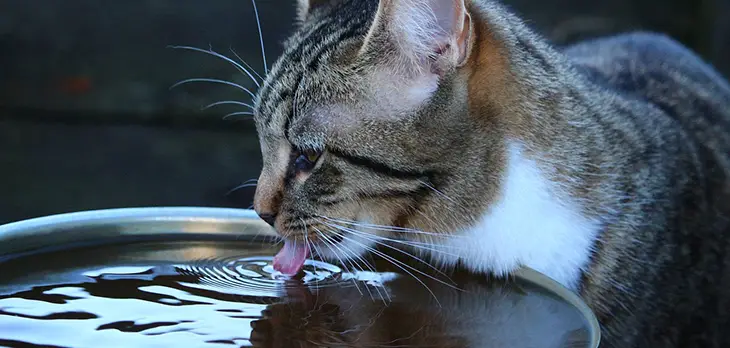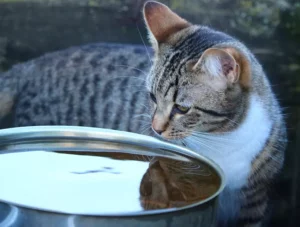4 Types of Worms in a Cat Water Bowl (And How To Prevent Them)
Finding worms in a cat water bowl is indeed worrisome for every pet parent. But before you panic, the good news is that most of these worms don’t come from your cat.
Still, it’s essential to know what enemies you’re facing. These worms can still cause harm to your cat’s health if not addressed immediately.

In this post, I discuss the different types of worms you may find in your cat’s bowl and how to prevent them. Whether your cat is healthy or immunocompromised, it’s essential to read this guide for your information.
Types of worms in a cat’s water bowl
1. White worms
White and long worms in your cat’s bowl could be Gordian worms. It’s a parasite, but not common to house pets like felines.
Young Gordian worms stay near a water source or vegetation until a host ingests them. Their typical hosts are insects and crustaceans.
Once mature, the worms trick the host into jumping into the nearest water. From there, the adult Gordian worms will leave their host’s body.
The good news is that Gordian worms are not parasitic to plants, pets, and humans. Still, it’s not something you’d want inside your cat’s body.
Gordian worms can cause diarrhea and vomiting in cats. It’s unlikely for the worms to grow longer inside your kitty’s body.
2. Brown worms
You must be worried about seeing light brown worms in your cat’s water bowl. While they may look like mosquito larvae, they can be dangerous roundworms.
Roundworms have a white to light brown color, which infests pets like cats and dogs. Once ingested, roundworms will wreak havoc in your cat’s digestive system.
It will trigger diarrhea, vomiting, coughing, and weakness. Over time, roundworms can also trigger rapid weight loss and a distended abdomen.
Please note that house cats may contract roundworms at some point in their lives. It can be due to contaminated water or through their mother’s milk.
Most healthy cats can overcome roundworms without medical intervention. It’s also essential to keep your feline’s water bowl clean and to deworm the kitty regularly.
3. Red worms
Red is often a color of danger, so it can be pretty shocking to see wiggly red creatures in your cat’s water bowl.
These reddish worms are often a variety of insect larvae, including those of mosquitoes. It doesn’t have any direct threat to your cat’s health, but it’s not something you want to live in their water bowl.
After all, these insects bite and spread diseases to humans. So while it will do little harm to your kitty, you might suffer from the inaction.
4. Black worms
What are little black worms in water, you ask? Most of the time, it’s just mosquito larvae.
Overall, ingesting mosquito larvae will not cause serious health issues for your cat. However, eliminating the contamination is still best, especially if your kitty has a sensitive tummy.
As mentioned, you should take action against mosquito larvae as it can put your family’s health at risk.
Although rare, mosquito larvae can also be carriers of heartworm, which can infect felines. If your cat ingested water with heartworm-infested larvae, it could suffer from a life-threatening infection.
This is why you should always observe proper hygiene regarding your cat’s feeding bowls.
What causes worms in water?
If you find any worms in a cat water bowl, they often come from the environment. This is more so if you have an outdoor cat or if the bowl is placed outdoors.
It’s usually a mix of insect larvae, which are generally harmless. Still, it shouldn’t mean that you should let your kitty swallow the icky creatures.
As mentioned earlier, mosquito larvae can be a cause of infections, which will compromise your feline’s health. It’s best to err on the side of caution instead of taking chances.
How to prevent worms in a cat water bowl
Preventing the harborage of worms in your cat’s water bowl is relatively easy. You only have to take these three proactive steps. Pay attention to signs from your cat if it does things like scratching the floor around its water bowl or if it stops drinking water for a long period of time.
1. Clean the bowl regularly
This should come as a no-brainer, but it’s still an important reminder for all pet owners. You must clean your cat’s water bowl every day and replace the water, too.
Some pet owners would do it every other day. But if your kitty’s water bowl is prone to worms, a daily cleaning habit won’t hurt anyone.
Aside from worms, the slimy biofilm that forms on the bowl’s surface will allow bacteria to grow. This is harmful to cats, with or without worms.

2. Consider a cat water fountain.
Switch to a water fountain if worms keep getting in your cat’s water bowl. Since the water is continuously moving in a fountain, insects find it difficult to lay eggs.
Aside from that, cats often prefer fresh and flowing water for a sip. This explains why many kitties like the faucet over their water bowl for a drink.
Also, a fountain will entice your cat to drink more due to the sound of trickling water. While it requires more maintenance, the benefits outweigh this small sacrifice.
3. Keep the area clean.
Lastly, ensure that the area where you keep your cat’s water bowl is clean. Get rid of anything that attracts insects, and avoid placing the bowl outdoors.
Most of all, keeping your cat clean is essential, especially if you let it roam outdoors. The dirt and parasites clung to its fur may transfer to the food bowls when it eats or drinks.
IMPORTANT REMINDER: Never use mosquito dunks on pet water bowls!
Some pet owners think placing a mosquito dunk in their cat’s water bowl will solve the worm problem. Sure, it will kill the larva, but it’s NOT safe for your cat to drink.
Mosquito dunks are non-toxic to humans, pets, marine life, and plants. However, it’s not designed for consumption.
In fact, mosquito dunks use active agents to get rid of the larva in water. Depending on your cat’s tolerance level, the use of dunks can lead to diarrhea, vomiting, and other complications.
Note that mosquito dunks are intended for water fountains and pools. If you want a passive solution, add a few drops of apple cider vinegar to the water.
Will my cat get sick from worms in the water bowl?
Yes, your cat can get sick from drinking worm-infested water. Some worms are harmless, but others can trigger symptoms like diarrhea, vomiting, and GI infection.
Aside from worms, a slew of bacteria can also live in your cat’s dirty water bowl. This will increase the risk of acquiring an infection once your kitty drinks the water.
Why are there worms in my pet’s water bowl?
The worms in your pet’s water bowl are often due to insects laying larvae like mosquitoes and flies. While it may not cause serious health threats to your cat, these larvae can put your family at risk.
Once the larvae mature and become insects, they will bite humans and spread infectious diseases. For the safety of everyone, it’s best to keep your cat’s water bowl clean.
Can cats get worms from the water bowl?
Cats can get a worm infection from their water bowls. The risk is higher if your cat shares the bowl with other pets or if you don’t clean the bowl regularly.
Aside from proper hygiene, you’ll have added peace of mind if you get your cat vaccinated and dewormed.
Conclusion
Worms can infest your cat’s water bowl if it’s not cleaned regularly. While most of these worms are harmless, some can be carriers of infection.
To be safe, you should always observe the cleanliness of your cat’s belongings. Still, you should avoid any preventive fads that may risk your pet’s life.
In case your cat suffers from adverse reactions after drinking worm-infested water, you should contact the vet. Your cat may need some medications to overcome the irritations.
